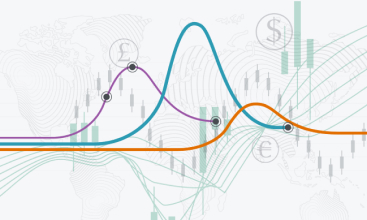Currency volatility:
Will the US dollar regain its strength?
Updated: July 28, 2025
Key takeaways
- U.S. moderation is expected to be USD-negative, and broad-based tariffs could amplify the dollar’s downtrend.
- On the other hand, the outlook for the euro is bullish, driven by medium-term factors including U.S. growth moderation and German fiscal support.
- Both fiscal and monetary policy could continue to weigh on the pound relative to the euro, even if they could both rise relative to the dollar.
- While the Japanese yen has depreciated against most G10 currencies, J.P. Morgan Global Research remains modestly bullish on JPY versus USD.
Introduction
Previously primed for new highs, the dollar has depreciated significantly in recent months. Its decline gained further momentum post-Liberation Day, with the U.S. experiencing growth downgrades and inflation upgrades on the back of the tariff announcements. As of July 11, the U.S. dollar index was down 10% year to date, marking its weakest first-half performance since at least 1980.
Looking ahead, improving global growth and rising commodity prices look set to create more cross-currents in the FX market. Against this backdrop of heightened forex volatility, what’s the outlook for the U.S. dollar, euro, British pound and Japanese yen?
The outlook for major currency pairs
Source: J.P. Morgan
GBP/USD is forecast to reach 1.37 in September 2025, 1.36 in December 2025, 1.39 in March 2026 and 1.37 in June 2026. EUR/USD is predicted to reach 1.19 in September 2025, 1.20 in December 2025, and 1.22 in March and June 2026. USD/JPY is expected to hit 141 in September 2025, 140 in December 2025, and 139 in March and June 2026.
Meera Chandan
Co-head of Global FX Strategy, J.P. Morgan
The outlook for the US dollar
In March, J.P. Morgan Global Research turned bearish on the dollar for the first time in four years — a view it continues to maintain for the medium term. “We look for more USD weakness this year, predicated on the same combination of cyclical factors (including U.S. moderation and tariffs) and structural factors (such as valuations, fiscal, flow dynamics and policy uncertainty) that we have been discussing for several months now,” said Meera Chandan, co-head of Global FX Strategy at J.P. Morgan.
Indeed, the macro landscape continues to be supportive of the bearish outlook. U.S. moderation is expected to be USD-negative, and broad-based tariffs could amplify the dollar’s downtrend. “The growth impact of such tariffs will be onerous globally, but the inflation impact will be differentiated — so inflationary for the U.S. and deflationary for the rest of the world (RoW). This should continue to weigh on real policy rates in the U.S., reducing the attractiveness of the dollar,” Chandan added.
Other U.S. policy channels could put further pressure on the greenback too. “On fiscal, the U.S. did pass the Trump administration’s mega bill, but there is no obvious growth-positive fiscal thrust after accounting for tariff revenue. This likely leaves the pass-through to USD skewed to the downside, given the implicit higher term premium and still-soft supply-demand dynamics in the Treasury market,” Chandan said. In addition, lower net immigration flows and the Trump administration’s push for the Fed to cut rates could further compound dollar weakness.
Granted, several systematic indicators have become less USD-bearish, which could point to some consolidation or even a rebound in the near term. “Our flagship growth momentum model has turned modestly USD bullish. However, we consider these signals less relevant over the medium term,” Chandan noted. “The underlying macro landscape is undergoing a significant shift, which means dislocations could get larger.”
The U.S. dollar has largely mirrored moves in Brent prices since late 2022.
The outlook for the euro
After holding a bearish view of the euro for most of 2024, J.P. Morgan Global Research turned bullish in March. “The German federal budget that was recently passed indicates more expansionary than expected fiscal policy, which is likely to support growth,” Chandan said. “The European Central Bank (ECB) has suggested that it could be approaching an end, or at least a pause, to the easing cycle. Though not a requirement for the euro-positive view, it is a euro-favorable development.”
EUR/USD tested its four-year high of 1.18 in July, driven by rate differentials and relative equity performance. “Fair value by most estimates is closer to 1.11 to 1.12, but we do not expect this to be a constraint on EUR/USD strength in the medium term. At worst, we expect a period of consolidation before a resumption toward further strength,” Chandan said.
Overall, J.P. Morgan Global Research expects EUR/USD to hit 1.19 by September 2025 and climb to 1.22 by March 2026. “While it is possible that FX markets could take a breather in the near term after recent large moves, we expect that the medium-term factors of U.S. moderation, currency hedges rebalancing, German fiscal support and changes in U.S. policy to be the more persistent bullish drivers of EUR/USD,” Chandan added.
The outlook for the British pound
Even though the pound has risen against the dollar in recent months, the outlook remains bearish. “It’s somewhat misleading to look at GBP/USD as a barometer of sterling performance given that most G10 currencies are near year-to-date highs versus what has been a very weak USD this year. The pound has underperformed its European peers and we think more is to come, particular versus EUR, CHF and Scandi currencies,” Chandan said.
Looking ahead, both fiscal and monetary policy could continue to weigh on the pound relative to peers. The U.K. labor market is softening, which could see the Bank of England (BoE) slashing rates later in the year. In addition, a decrease in spending cuts suggests the Autumn budget could see sharper fiscal tightening, putting yet more pressure on the sterling.
“With markets having been positioned in long GBP/USD, U.K. vulnerabilities have been swept under the carpet. As a result, there is a bearish feedback loop that we think isn’t priced into the currency, where weak growth requiring more fiscal tightening, which then weakens growth further, which requires more fiscal tightening,” Chandan observed.
All things considered, J.P. Morgan Global Research predicts GBP/USD could fall to 1.36 by December 2025, before recovering to 1.39 by March 2026. “If the fiscal and monetary channels do weaken GBP further, that in our view should allow markets to more appropriately price the longer-term GBP vulnerabilities including persistent basic balance deficits, supply-side labor market issues and relative productivity underperformance,” Chandan added.
The outlook for the Japanese yen
The Japanese yen has broadly weakened in recent weeks. Since the Liberation Day announcement, it has depreciated against most G10 currencies besides the USD, resulting in a 2.3% decline in trade-weighted terms. J.P. Morgan Global Research’s bullish yen view hinges, above all, on U.S. moderation, which it should be a key beneficiary of.
“We believe the recent weakness has been driven by a gradual unwinding of speculative JPY long positions due to factors such as rising stock prices, improved risk sentiment, retreating expectations for rate hikes, fiscal concern amid heightening uncertainties surrounding domestic politics, waning expectations for a U.S.–Japan currency agreement and the lack of a de-dollarization movement in Japan,” Chandan noted. “However, the expected impact of the aforementioned factors is mixed and they are likely to offset each other, resulting in a limited overall impact.”
Tariffs are unlikely to significantly affect Japan’s trade balance, reflecting the country’s low dependence on external demand and high local production. However, if they bring about a decline in Japanese stock prices, the yen could appreciate as a result — at least in the short term.
All in all, despite recent developments, J.P. Morgan Global Research remains modestly bullish on JPY versus USD and expects USD/JPY to end the year at 140, before falling to 139 in March 2026.
Related insights
This communication is provided for information purposes only. Please read J.P. Morgan research reports related to its contents for more information, including important disclosures. JPMorgan Chase & Co. or its affiliates and/or subsidiaries (collectively, J.P. Morgan) normally make a market and trade as principal in securities, other financial products and other asset classes that may be discussed in this communication.
This communication has been prepared based upon information, including market prices, data and other information, from sources believed to be reliable, but J.P. Morgan does not warrant its completeness or accuracy except with respect to any disclosures relative to J.P. Morgan and/or its affiliates and an analyst's involvement with any company (or security, other financial product or other asset class) that may be the subject of this communication. Any opinions and estimates constitute our judgment as of the date of this material and are subject to change without notice. Past performance is not indicative of future results. This communication is not intended as an offer or solicitation for the purchase or sale of any financial instrument. J.P. Morgan Research does not provide individually tailored investment advice. Any opinions and recommendations herein do not take into account individual client circumstances, objectives, or needs and are not intended as recommendations of particular securities, financial instruments or strategies to particular clients. You must make your own independent decisions regarding any securities, financial instruments or strategies mentioned or related to the information herein. Periodic updates may be provided on companies, issuers or industries based on specific developments or announcements, market conditions or any other publicly available information. However, J.P. Morgan may be restricted from updating information contained in this communication for regulatory or other reasons. Clients should contact analysts and execute transactions through a J.P. Morgan subsidiary or affiliate in their home jurisdiction unless governing law permits otherwise.
This communication may not be redistributed or retransmitted, in whole or in part, or in any form or manner, without the express written consent of J.P. Morgan. Any unauthorized use or disclosure is prohibited. Receipt and review of this information constitutes your agreement not to redistribute or retransmit the contents and information contained in this communication without first obtaining express permission from an authorized officer of J.P. Morgan.
Copyright 2024 JPMorgan Chase & Co. All rights reserved.
Related insights
-

Global Research
De-dollarization: Is the US dollar losing its dominance?
July 01, 2025
Top dollar no more? Learn more about the factors threatening the dominance of the world’s reserve currency.
-

Global Research
Mid-year market outlook 2025: A broad spectrum of potential outcomes
July 01, 2025
The persistent backdrop of policy uncertainty, coupled with geopolitical risks, portends increased macroeconomic volatility for the second half of the year. What’s the outlook for equities, commodities, currencies, emerging markets and more?
-

Global Research
Global Research
Leveraging cutting-edge technology and innovative tools to bring clients industry-leading analysis and investment advice.
This material (Material) is provided for your information only and does not constitute: (i) an offer to sell, a solicitation of an offer to buy, or a recommendation for any investment product or strategy, or (ii) any investment, legal or tax advice. The information contained herein is as of the date and time referenced in the Material and J.P. Morgan does not undertake any obligation to update such information. J.P. Morgan disclaims any responsibility or liability, whether in contract, tort (including, without limitation, negligence), equity or otherwise, for the quality, accuracy or completeness of the information contained in this Material, and for any reliance on, or uses to which, this Material, is put, and you are solely responsible for any use to which you put such information. Without limiting any of the foregoing, to the fullest extent permitted by applicable law, in no event shall J.P. Morgan have any liability for any special, punitive, indirect, or consequential damages (including lost profits or lost opportunity), in connection with the information contained in this Material, even if notified of the possibility of such damages. Any comments or statements made herein do not necessarily reflect those of J.P. Morgan, its subsidiaries or its affiliates.
All materials and information shared with you are, unless otherwise indicated to you, proprietary and confidential to J.P. Morgan. You are hereby notified that any disclosure, dissemination, copying, distribution, or use of the information provided to you, in whole or in part, other than as expressly permitted by J.P. Morgan, is STRICTLY PROHIBITED. You are permitted to disclose the materials and information to your officers and employees on a need to know basis. Should you have any questions regarding this, please contact your usual J.P. Morgan contact. For further information please visit: Sales and Trading Disclaimer.
© 2025 JPMorgan Chase & Co. All rights reserved. J.P. Morgan is a marketing name for businesses of JPMorgan Chase & Co. and its subsidiaries and affiliates worldwide. JPMorgan Chase Bank N.A. (member of FDIC), J.P. Morgan Securities LLC (member of FINRA, NYSE and SIPC), J.P. Morgan Securities plc (member of the London Stock Exchange and authorized by the Prudential Regulation Authority (PRA) and regulated by the Financial Conduct Authority and the PRA) and J.P. Morgan SE (authorised by the BaFin and regulated by the BaFin, the German Central Bank and the European Central Bank) are principal subsidiaries of JPMorgan Chase & Co. For legal entity and regulatory disclosures, visit: www.jpmorgan.com/disclosures. For additional regulatory disclosures, please consult: www.jpmorgan.com/disclosures.





